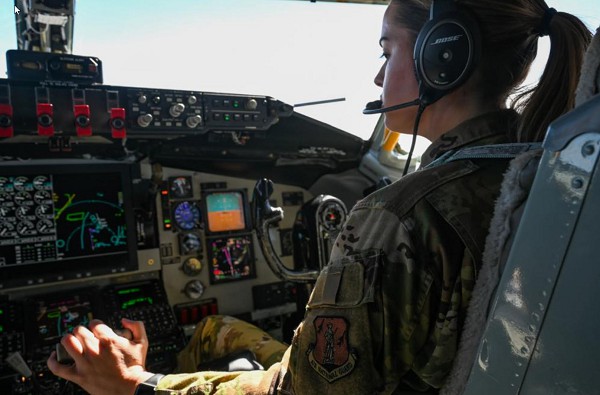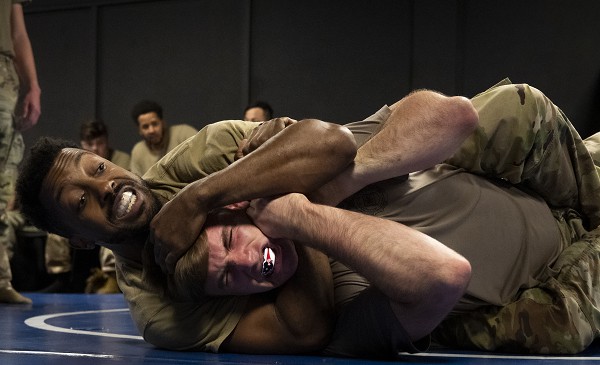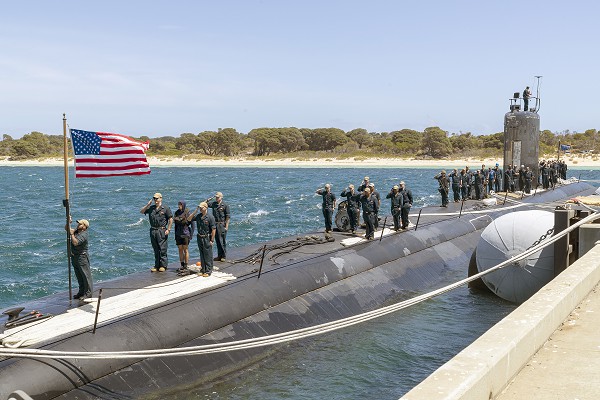- Details
- Hits: 547

MacDill Air Force Base, Florida. (February 14, 2033): In this photo by Tech Sgt. Diana Cossaboom, U.S. Air Force Capt. Sydney Hultz, a KC-135 Stratotanker pilot assigned to the 91st Expeditionary Air Refueling Squadron, flies the aircraft over the U.S. Central Command area of responsibility. The KC-135 delivers fuel for U.S. and partner nation forces, extending the reach of allied aircraft to the far regions of the world.
The KC-135 Stratotanker provides the core aerial refueling capability for the United States Air Force and has excelled in this role for more than 60 years. Currently, the KC-135 fleet provides aerial refueling support to Air Force, Navy, Marine Corps, and allied nation aircraft. The plane is also capable of transporting litter and ambulatory patients using patient support pallets during aeromedical evacuations.
The 91st Air Refueling Squadron is part of the 6TH Air Mobility Wing that was first activated in January 1941 as the 1st Reconnaissance Squadron at Langley Field, Virginia. Today, these long-range tanker aircraft are capable of refueling a variety of aircraft in mid-air, anywhere in the world, and under all weather conditions.
The tricky part of arial refueling is the delicate dance between approaching aircraft and this flying gas station which dispenses thousands of gallons of aviation fuel in mid-air. The receiving aircraft must maneuver into position behind the KC135 while flying at 30,000 feet and speeds up to 530 mph. The pilot skillfully connects the plane to a special shuttlecock-shaped drogue attached to and trailing behind the flying boom to refuel. Some aircraft have been configured with a multipoint refueling system, which consists of special pods mounted on the wingtips, that allows the KC-135s to refuel two aircraft at the same time.
- Details
- Hits: 487

Minot Air Force Base, North Dakota. (February 23, 2023): In this photo by Staff Sergeant Michael A. Richmond, crew chiefs assigned to the 23rd Aircraft Maintenance Squadron run toward a 23rd Bomb Squadron B-52H Stratofortress to remove the chocks before launching the aircraft to Moron Air Base, Spain. The Spaniards played host for Bomber Task Force 23-2, an exercise to familiarize aircrews with the overseas bases they would use in the event of war.
For the pilots and crews of the 23rd, this deployment reads like a European vacation. The mission began with a low approach flyby of 2 B-52H Stratofortress aircraft in Tallinn, Estonia, in celebration of Estonia’s Independence Day. Next, the Squadron flew sorties in Northern Europe with British Royal Air Force F-35s in close-air-support training with Norwegian Joint-Terminal Attack Controllers. Last week, the 23rd joined French and Spanish forces to practice delivering nuclear and conventional firepower to simulated targets.
The squadron is one of the oldest in the Air Force, having deployed to England as part of the American Expeditionary Forces during World War I, and the unit saw action in World War II. The 23rd later became part of the famous Strategic Air Command (SAC) protecting America during the Cold War.
Read more: Older than the crews that fly them… B-52 BOMBER IS STILL AMERICA’S “BACKBONE”
- Details
- Hits: 471

Eglin Air Force Base, Florida. (February 16, 2023): In this Air Force photo by Samuel King Jr., Staff Sgt. Jared Elliot puts Airman 1st Class Hunter Warren in a choke hold during a training class that is part of a new consolidated curriculum combining the needs of security forces with those of combat-ready deployment forces. Conducted by the 96th Security Forces Squadron, this combined approach is more “combat focused” than traditional law enforcement training and will become the standard for Air Force instruction.
The goal is to ensure security forces are always ready for combat, not just prior to deployment. The program consists of nine days of classroom and hands on training covering physical combat tactics, casualty care, close-quarters combat, and how to use a variety of weapons. The 96TH Security Forces Squadron is headquartered at Eglin Air Force Base in the western Florida Panhandle which serves as the Air Forces’ test and evaluation center. The base plans, directs, and conducts tests and evaluation of U.S. and allied air armament, navigation and guidance systems, and command and control systems.
The group provides fuel, supply, transportation, ground combat training, security, communication, personnel, education, family services, lodging, food service, recreation and logistics planning and deployment support to approximately 20,000 military and civilian personnel and 43,000 retirees.
Eglin AFB is named in honor of Lt. Col. Frederick I. Eglin (1891-1937), who was killed in a crash of his Northrop A-17 attack aircraft on a flight from Langley to Maxwell Field, Alabama.
- Details
- Hits: 379

Garden Island, Australia (February 27, 2023): In this photo courtesy of the Australia Department of Defense, Sailors assigned to the Los Angeles-class fast-attack submarine USS Asheville salute the national ensign after arriving at Royal Australian Navy Stirling Naval Base. Sailors volunteer to serve aboard America’s submarine fleet, an undersea world of cramped spaces, no sense of time, and shared bunks in a 24 hour a day operation. Aboard the Asheville, Sailors spend six months at sea with each deployment and must endure constant shift work while working at incredibly close quarters with their comrades. Life beneath the waves has certain unwritten rules of behavior to keep the peace on long voyages. The primary rule is avoid making loud noises, such as slamming hatchway doors, which is strictly forbidden as someone is always sleeping.
As one can imagine, space aboard a submarine is extremely limited. One third of the vessel contains the nuclear powerplant leaving precious little room for the crew who will spend six months trying to get along with their fellow Sailors. Every space is designed for multiple uses and sleeping space is at a premium. In fact, a sub has more Sailors than beds which means shared bunks and rotating sleep cycles around the clock.
- Details
- Hits: 412

Washington, D.C. (March 2, 2023): In this photo by Corporal Tanner Lambert, Lance Corporal Justin Shevlin folds the U.S. flag during a funeral for repatriated Marine Corporal Thomas H. Cooper who was killed on the Tarawa Atoll of the Gilbert Islands during World War II.
Corporal Cooper, 22, from Chattanooga, Tennessee, was a member of A Company, 2nd Amphibious Tractor Battalion, 2nd Marine Division which landed against stiff Japanese resistance in this famous battle.
Over several days of intense fighting, approximately 1,000 Marines and Sailors were killed and more than 2,000 were wounded while the Japanese were virtually annihilated. Cooper died on the first day of the battle and was reportedly buried on Betio Island. Despite the heavy casualties suffered by U.S. forces, success in the battle of Tarawa was a huge victory for the U.S. military in the Central Pacific Campaign against Japan.
- Details
- Hits: 504

ALBANIA (February 22, 2023): In this photo by Petty Officer 2nd Class Novalee Manzella, Spanish Marines climb aboard a U.S. Navy MH-60S Sea Hawk helicopter during interoperability training in Albania. Carrier Air Wing 7, the offensive attack component of the George H.W. Bush Carrier Strike Group, is on a scheduled deployment of the U.S. Sixth Fleet to defend U.S. and allied partner interests. Naval Forces Europe consists of six nuclear-powered aircraft carriers, 54 aircraft squadrons, 1,200 aircraft, and 43,000 officers, enlisted and civilian personnel based on the East Coast of the United States.
The Spanish troops are part of the U.S. Navy’s “Stronger Together” campaign to integrate allied ships and aircraft in the Mediterranean. The Spanish and American Navies share many historical and cultural ties and a commitment to the defense of the citizens and territories of NATO Allies.


